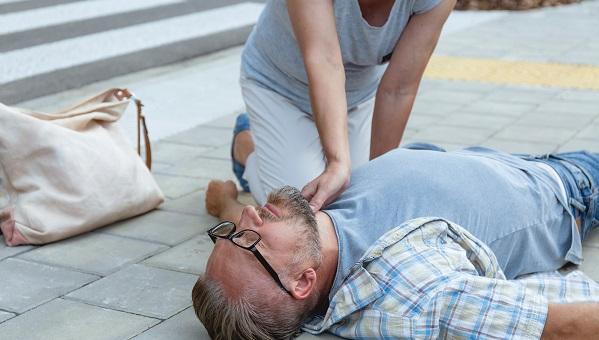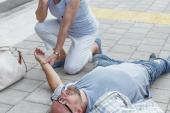No Need to Cool Out-of-Hospital Cardiac Arrest Patients: TTM2
Two decades into therapeutic hypothermia, clinicians must face the fact that it doesn’t seem to work for OHCA.

There’s no benefit to therapeutic hypothermia for comatose patients who’ve experienced out-of-hospital cardiac arrest (OHCA), according to the long-awaited TTM2 trial. Mortality, neurological function, and quality of life all were similar irrespective of whether patients were cooled to 33°C or simply prevented from having a fever.
The results, which challenge two decades’ worth of practice, may well spell the end for cooling as a goal of targeted temperature management (TTM), senior author Niklas Nielsen, MD, PhD (Helsingborg Hospital, Sweden), told TCTMD. There may still be a role for targeted normothermia, though this merits further study, he said.
Current guidelines recommend that hypothermia should fall in the range between 32°C and 36°C, thanks to the 275-patient HACA trial and the 77-patient trial by Bernard et al, both published in 2002. Ever since the negative TTM trial came out in 2013, however, there’ve been new data and debate over how various approaches to cooling OHCA patients might bear fruit. Most recently, CAPITAL-CHILL contributed to that discussion by showing no difference between patients cooled to 31°C rather than 34°C.
TTM2, with Josef Dankiewicz, MD, PhD (Skåne University Hospital Lund, Sweden), as lead author, has now been published in the New England Journal of Medicine. Nielsen expects that US and European guidelines will take its results into consideration. “I think they will assess all the available evidence and come up with an answer,” he said.
If we give the cardiac arrest patient the full protocolized care, no matter what temperature we target, I think we can push the numbers higher and have better outcomes. Niklas Nielsen
“There is basic science, animal evidence, that supports the use of therapeutic hypothermia. But then the clinical implications for adult cardiac arrest are based on quite low-certainty evidence that is almost 20 years old,” Nielsen continued, noting that these earlier trials had small sample sizes and weren’t as rigorously designed as they would be now. “We might have jumped the [gun] to use therapeutic hypothermia a little bit too early. . . . So I would say that today there is no hard evidence that cooling cardiac arrest patients in any category is beneficial,” he said.
That said, the initial enthusiasm wasn’t in vain, Nielsen pointed out, as it drew attention to the need for strategies to address OHCA.
“Cardiac arrest patients 25 years ago, they were approached with quite some nihilism. Today we have a different approach,” he said. “We should give them the best standard of care when it comes to cardiac interventions [and] neuroprognostication and follow-up and rehabilitation. If we give the cardiac arrest patient the full protocolized care, no matter what temperature we target, I think we can push the numbers higher and have better outcomes.”
Interpretation of the findings will be mixed, Le May commented. With no differences seen in outcomes across the board, “people will walk away from that and say, ‘Well, what’s the story with cooling?’” Importantly, even in the normal-temperature group, almost half of patients required device-based cooling to address fever, he observed.
Prior to the first TTM trial, there already had been some hypothermia doubters and “that group now I think is going to grow,” Le May predicted. As for not treating fever, which doesn’t yet have evidence in its favor, he said the temperature cutoff for when to initiate treatment will likely be fuzzier in clinical practice than in a trial setting.
“I think that this study is going to make people kind of uncomfortable with the use of endovascular cooling devices. There may be a shift towards pads or blankets, but I think altogether there’s going to be a sizeable decrease in the use of devices,” such that individuals who’ve experienced OHCA could be treated like any other ICU patient when it comes to body temperature, said Le May. Increasingly, the solution may be pharmacological.
“There are going to be a lot of consultations among interventional cardiologists, intensivists, all across the ICUs and CICUs in terms of deciding how they approach this [problem],” he added. “This trial, I would qualify it almost for us like the ‘trial of the decade.’”
There are going to be a lot of consultations among interventional cardiologists, intensivists, all across the ICUs and CICUs in terms of deciding how they approach this [problem]. Michel R. Le May
TTM2 enrolled 1,900 adults with coma after OHCA of presumed cardiac or unknown cause, randomizing them to hypothermia at 33°C followed by controlled rewarming or normothermia at ≥ 37.8°C with early treatment of fever.
Nearly all (95%) of the hypothermia group underwent cooling with a device, though nearly half (46%) of the normothermia group did so, as well. Among those assigned to cooling, the reasons for not receiving the therapy were intracranial hemorrhage, early death, early awakening, hemodynamic instability, and referral for cardiac surgery, whereas for the normal-temperature group, the main reason was not reaching the set definition for fever. Around 70% of the devices in each group were surface and 30% intravascular.
The trial’s primary outcome was all-cause death at 6 months. By this time, approximately half of patients in each group had died (50% with hypothermia vs 48% with normothermia; P = 0.37). At least moderately severe disability (modified Rankin scale score ≥ 4) was seen in 55% of cooled patients and 55% of normal-temperature patients. No differences were observed with regard to sex, age (above or below 65 years), time to return of spontaneous circulation after cardiac arrest (above or below 25 minutes), initial rhythm (shockable vs nonschockable), and whether shock was present at the time of admission.
Additionally, cooling came at the cost of increased arrhythmias resulting in hemodynamic compromise (24% vs 17%; P < 0.001).
“In the real world,” said Le May, “how many times are you going to be putting in an endovascular cooling device or applying the blankets to cool the patient if the temperature nudges a little bit above normal? Imagine you’ve got a patient, you get called by the nurse at midnight and the temperature is a little bit [high]. . . . You might say: ‘Why don’t we give Tylenol and we’ll reassess in the morning.’”
Not Just Hypothermia
Laurie J. Morrison, MD (University of Toronto, Canada), and Brent Thoma, MD (University of Saskatchewan, Saskatoon, Canada), take a different perspective. Writing in an editorial, they call the dismissal of therapeutic hypothermia in the wake of the original TTM trial “illustrative and alarming.”
Clinicians moved away from cooling, they say, perhaps because they “misinterpreted the results as indicating that a targeted temperature management protocol was without benefit and that normothermia could be achieved with acetaminophen alone.” But the impressive outcomes achieved in that trial were only possible thanks to a “suite of targeted interventions, including the use of sedation and cooling devices in a similar percentage of patients in both groups. The key message from [TTM] was that targeted temperature management is required, regardless of the target temperature chosen.”
Both TTM and TTM2, with advances in critical care and a uniform approach, far exceeded the historical mortality rate of 25% seen with OHCA, Morrison and Thoma note. “The key takeaway from the TTM2 trial for clinicians should be that targeted temperature management involving pharmacotherapy, device cooling, and timely neurologic prognostication is a crucial treatment strategy to improve outcomes in patients who have had a cardiac arrest. The target temperature, at the discretion of the clinician, could be 33°C, 36°C, or 37.5°C or less.”
In his own practice going forward, Nielsen said he sees no reason to push OHCA patients toward hypothermia. Yet he made a point similar to that aired by the editorialists—because TTM2 employed a strict protocol to achieve normothermia in the control group, it’s not that temperature targets have been done away with entirely. “I think we should still follow temperature. We should avoid fever,” though this approach, too, lacks strong evidence, stressed Nielsen. “We need to push that question in further clinical trials.”
Studies on in-hospital cardiac arrest are ongoing, as is the ICECAP trial testing hypothermia duration in OHCA, he noted.
As research continues, a tweet by study co-author Paul Young, MD (Wellington Hospital, New Zealand), has amplified the message that TTM2 “should herald the end of the era of therapeutic hypothermia for adult cardiac arrest.”
This thread on the #TTM2 trial has now been viewed >280,000 times. This is more than 10xs more times than the @NEJM paper has been downloaded and more than 100xs as many times as the editorial accompanying the paper has been downloaded. https://t.co/EYomvi4B9y
— Paul Young (@DogICUma) June 19, 2021
Caitlin E. Cox is News Editor of TCTMD and Associate Director, Editorial Content at the Cardiovascular Research Foundation. She produces the…
Read Full BioSources
Dankiewicz J, Cronberg T, Lilja G, et al. Hypothermia versus normothermia after out-of-hospital cardiac arrest. N Engl J Med. 2021;384;2283-2294.
Morrison LJ, Thoma B. Translating targeted temperature management trials into postarrest care. N Engl J Med. 2021;384;2344-2345.
Disclosures
- Nielsen reports receiving lecture fees from Bard Medical and consulting fees from BrainCool.
- Dankiewicz, Morrison, and Toma report no relevant conflicts of interest.





Comments